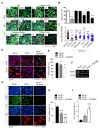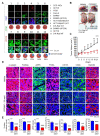A Small Molecule Promoting Neural Differentiation Suppresses Cancer Stem Cells in Colorectal Cancer
- PMID: 35453609
- PMCID: PMC9025482
- DOI: 10.3390/biomedicines10040859
A Small Molecule Promoting Neural Differentiation Suppresses Cancer Stem Cells in Colorectal Cancer
Abstract
Cancer stem cells (CSCs) are a tumor cell subpopulation that drives tumor progression and metastasis, leading to a poor overall survival of patients. In colorectal cancer (CRC), the hyper-activation of Wnt/β-catenin signaling by a mutation of both adenomatous polyposis coli (APC) and K-Ras increases the size of the CSC population. We previously showed that CPD0857 inactivates Wnt/β-catenin signaling by promoting the ubiquitin-dependent proteasomal degradation of β-catenin and Ras proteins, thereby decreasing proliferation and increasing the apoptosis of CRC lines. CPD0857 also decreased the growth and invasiveness of CRC cells harboring mutant K-Ras resistant to EGFR mAb therapy. Here, we show that CPD0857 treatment decreases proliferation and increases the neuronal differentiation of neural progenitor cells (NPCs). CDP0857 effectively reduced the expression of CSC markers and suppressed self-renewal capacity. CPD0857 treatment also inhibited the proliferation and expression of CSC markers in D-K-Ras MT cells carrying K-Ras, APC and PI3K mutations, indicating the inhibition of PI3K/AKT signaling. Moreover, CPD0857-treated xenograft mice showed a regression of tumor growth and decreased numbers of CSCs in tumors. We conclude that CPD0857 could serve as the basis of a drug development strategy targeting CSCs activated through Wnt/β-catenin-Ras MAPK-PI3K/AKT signaling in CRCs.
Keywords: K-Ras; Wnt/β-catenin; cancer stem cell; colorectal cancer; neural progenitor cell.
Conflict of interest statement
The authors declare no competing interests.
Figures




Similar articles
-
Small Molecule Destabilizer of β-Catenin and Ras Proteins Antagonizes Growth of K-Ras Mutation-Driven Colorectal Cancers Resistant to EGFR Inhibitors.Target Oncol. 2020 Oct;15(5):645-657. doi: 10.1007/s11523-020-00755-5. Target Oncol. 2020. PMID: 33026592
-
Role of oncogenic K-Ras in cancer stem cell activation by aberrant Wnt/β-catenin signaling.J Natl Cancer Inst. 2014 Feb;106(2):djt373. doi: 10.1093/jnci/djt373. J Natl Cancer Inst. 2014. PMID: 24491301
-
Interaction of the Wnt/β-catenin and RAS-ERK pathways involving co-stabilization of both β-catenin and RAS plays important roles in the colorectal tumorigenesis.Adv Biol Regul. 2018 May;68:46-54. doi: 10.1016/j.jbior.2018.01.001. Epub 2018 Jan 10. Adv Biol Regul. 2018. PMID: 29449169 Review.
-
A mutant KRAS-induced factor REG4 promotes cancer stem cell properties via Wnt/β-catenin signaling.Int J Cancer. 2020 May 15;146(10):2877-2890. doi: 10.1002/ijc.32728. Epub 2019 Nov 23. Int J Cancer. 2020. PMID: 31605540
-
Interaction between Wnt/β-catenin and RAS-ERK pathways and an anti-cancer strategy via degradations of β-catenin and RAS by targeting the Wnt/β-catenin pathway.NPJ Precis Oncol. 2018 Feb 20;2(1):5. doi: 10.1038/s41698-018-0049-y. eCollection 2018. NPJ Precis Oncol. 2018. PMID: 29872723 Free PMC article. Review.
Cited by
-
The Role of Tumor Stem Cells in Colorectal Cancer Drug Resistance.Cancer Control. 2024 Jan-Dec;31:10732748241274196. doi: 10.1177/10732748241274196. Cancer Control. 2024. PMID: 39215442 Free PMC article. Review.
-
Periampullary cancer and neurological interactions: current understanding and future research directions.Front Oncol. 2024 Mar 19;14:1370111. doi: 10.3389/fonc.2024.1370111. eCollection 2024. Front Oncol. 2024. PMID: 38567163 Free PMC article. Review.
References
-
- Merlos-Suarez A., Barriga F.M., Jung P., Iglesias M., Cespedes M.V., Rossell D., Sevillano M., Hernando-Momblona X., da Silva-Diz V., Muñoz P., et al. The intestinal stem cell signature identifies colorectal cancer stem cells and predicts disease relapse. Cell Stem Cell. 2011;8:511–524. doi: 10.1016/j.stem.2011.02.020. - DOI - PubMed
Grants and funding
LinkOut - more resources
Full Text Sources
Research Materials
Miscellaneous

